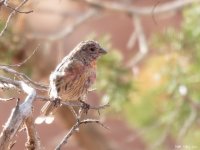MattDinUtah
Member

I'm a brand new birder, aside from being curious in the past and looking something specific up I've never done any birding before I started taking photos of them about six weeks ago. I have the National Geographic Guide to Western Birds of North America and have been using it to try and identify the birds I see in my backyard.
In looking at a bird recently I noticed a discrepancy, at least to my eyes, in what the guild was telling me and what I was seeing. I'm wrestling with the differences between a house finch and Cassin's finch (I believe this bird to be a finch, just trying to determine which one). For the male house finch, my guide says that the house finch can have red, orange or occasional yellow coloring, brownish streaked flanks and a blocked off tail. Cassin's finch has long bill with a straight culmen, red and pale pink coloring with fine streaks on the flanks and a strongly notched tail.
The picture I included here is of what I think is a house finch, his beak is not long (to my eyes anyway), he has pink, orange and yellow coloring, his flank streaks are not fine (again, to my eye), though his tail is notched.

My bigger question is when evaluating a bird are there certain characteristics that weigh more heavily in that evaluation? For example, is the bill most important or the coloring or the tail shape or is it a combination driven by experience and looking at thousands of birds that give one the ability to figure it out? Just trying to wrap my head around how I need to start learning how to differentiate different birds that look very similar to me.
I took the above picture this morning, August 1, 2021, in Kanab, Utah.
In looking at a bird recently I noticed a discrepancy, at least to my eyes, in what the guild was telling me and what I was seeing. I'm wrestling with the differences between a house finch and Cassin's finch (I believe this bird to be a finch, just trying to determine which one). For the male house finch, my guide says that the house finch can have red, orange or occasional yellow coloring, brownish streaked flanks and a blocked off tail. Cassin's finch has long bill with a straight culmen, red and pale pink coloring with fine streaks on the flanks and a strongly notched tail.
The picture I included here is of what I think is a house finch, his beak is not long (to my eyes anyway), he has pink, orange and yellow coloring, his flank streaks are not fine (again, to my eye), though his tail is notched.

My bigger question is when evaluating a bird are there certain characteristics that weigh more heavily in that evaluation? For example, is the bill most important or the coloring or the tail shape or is it a combination driven by experience and looking at thousands of birds that give one the ability to figure it out? Just trying to wrap my head around how I need to start learning how to differentiate different birds that look very similar to me.
I took the above picture this morning, August 1, 2021, in Kanab, Utah.



